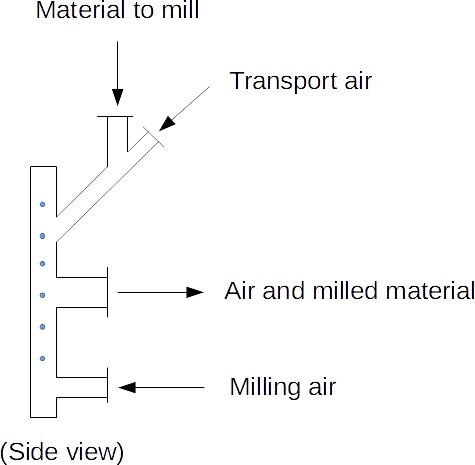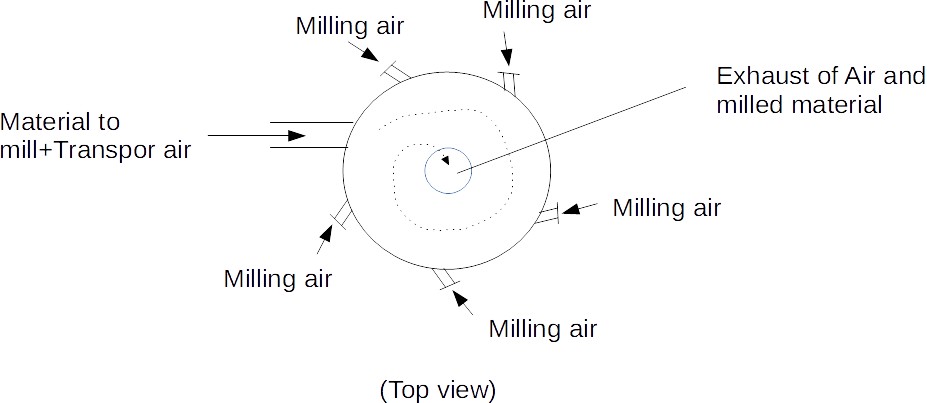
Jet Milling
What is jet milling ? How does a jet mill work ?
Fluidized bed jet mills and other design explained
Follow us on Twitter ![]()
Question, remark ? Contact us at admin@powderprocess.net
| Section summary |
|---|
| 1. What is a jet
mill ? |
| 2. How does a jet
mill work ? |
| 3. Industrial jet
milling |
1. What is a jet mill ?
Jet mills are used to reduce the particle size, i.e. granulometry, of bulk solids thanks to a high speed gas (air, steam) jet. Those bulk solids can be of different natures, typically foodstuff, pharmaceuticals, metal powders or minerals. In the quite large family of comminution equipment (size reduction equipment), and more particularly of impact mills, jet milling machines have the particularity to have no moving part as the energy is supplied by a gas released at high speed in a milling chamber where coarse particles are also introduced. The milling mechanism is only by impact of the particles in between the particles themselves or against the walls of the milling chamber.
What are the advantages of jet mills ?
Jet mills have several advantages that can make them attractive to companies :
- There is no moving part in the milling chamber, so it is reliable and not prone to risks of mechanical breakages or wear that could cause some pollution of the final product
- It allows a narrow particle size distribution (PSD)
- It allows to reach very fine particle size, possibly in the 1-10 microns range for some materials
What are the disadvantages of jet mills ?
Due to its technology, based on the injection of a gas (typically air, or an inert gas like nitrogen, argon, however steam can also be used), jet mills have also some limitations to consider :
- High energy consumption to compress the gas. It means that jet mills are used mainly for special products at high added value, for which the process becomes competitive
- Need to have a separation system integrated to recover the product from the gas used to perform the milling : brings additional costs and requires more footprint
Top
5 Most Popular
1.
Pneumatic transport design guide
2. Ribbon
blenders
3. Powder mixing
4. Hoppers design guide
5. Measuring degree of
mixing
--------------
 --------------
--------------
Top 5 New
1.
Continuous Dry Mixing
2. Mixing speed
3. Mixer cycle time optimization
4. Batch / continuous mixing
comparison
5. Energy Savings
2. How does a jet mill work ?
The working principle of jet mills is explained in this part.
2.1 High velocity impact
The principle of size reduction applied in a jet milling machine is to have high velocity impact, in between the particles, and in between the particles and the milling chamber. A gas (typically air, for air jet mills) injected at high speed provides the energy required for having many multiple high speed impacts leading to a very strong comminution of the feed particles.2.2 Grinding gas
The gas used in jet mill is usually one of the following :
- Air : the most common and most available gas, although not the cheapest as the compression work required requires a lot of energy. The pressure is typically 3.5-8.5 bar g [Liu]
- Steam : actually cheaper than air if the factory is equipped with efficient boilers. However steam can only be used if it does not interact with the material (heat...). Typical pressures are 7-15 bar g with temperatures 200-520 c [Liu]
- Inert gases : nitrogen or Argon can be used in some particular applications
2.3 Jet mills components
Suppliers are proposing 2 types of design [Liu] :
- Fluidized bed jet mills
- Flat / circular jet mills without an air classifier
2.3.1 Fluidized bed jet mills
Those mills are equipped with vertical, cylindrical, milling chamber in which the material is introduced at the middle of the chamber, and the grinding gas injecting a the bottom. The air and product exhaust is from the top of the chamber, however the outlet is equipped with a classifier allowing to select which particles, below a target size, can leave the mill, and which ones need to be recycled back to the milling chamber. As the gas is injected at the bottom of the chamber, the particles are fluidized with circulation streams establishing, hence the denomination of fluidized bed jet mill.

2.3.2 Flat / circular jet mills without an air classifier
The other design is simpler, the material is fed into a grinding chamber similar to a disc where the gas is injected at several points. The air and the material milled is then exiting at the center of the grinding chamber.


Figure 2 : spiral jet mill
2.3.3 Feeding system
The feeding system to the milling chamber must act as an airlock in order to avoid that the air escape and prevent the inlet of material.
2.4 Gas - Solid separation
The milled particles are leaving the mill with a large volume of
gas. It is then required to separate the material of interest,
from the gas. It is typically done thanks to a cyclone,
a filter of a
combination of them.
3. Industrial jet milling machines
Jet
mills can be designed up from few kg / h, typically for
R&D lab environment, up to 6 t/h [Chamayou]. Even if it is
possible to reach such high capacities, it appears that most
jet mills have a size of few dozens to few hundreds kg/h as
they are employed mainly for specific productions in pharma
or in cosmetics. Very large jet mills also requires a
lot of
energy to compress high quantities of gas, making their
economical justification limited to very specific cases.
4. Application of jet mills
Jet mills are used in a wide range of industries for the micronization of various materials.
In the pharmaceutical industry, jet mills are used to micronize active pharmaceutical ingredients, making them easier to dissolve and enhancing their bioavailability.
In the food industry, jet mills can be used to micronize spices, herbs, and other food ingredients to improve their flavor and texture.
In the chemical industry, jet mills are used to micronize pigments, dyes, and other materials to improve their color and dispersion properties.
Jet mills can also be used for micronization in the cosmetics, ceramics, and metallurgy industries. Jet mills offer advantages over other milling technologies due to their ability to produce fine, uniform particles and their low contamination rates. With the ability to control the particle size distribution and tailor it to specific applications, jet mills have become an essential tool in many industries for the micronization of materials.
Source